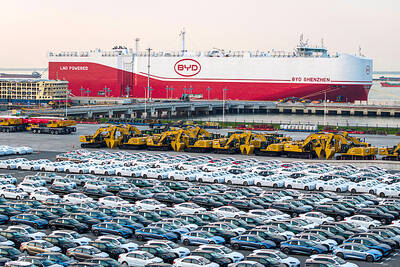China Airlines Ltd (CAL, 中華航空) yesterday said that its low-cost carrier Tigerair Taiwan (台灣虎航) returned to profit last month, following the ending of the subsidiary’s partnership with a Singaporean peer.
Tigerair Taiwan, a joint venture between CAL and Tiger Airways Singapore Pte Ltd, became the Taiwanese carrier’s wholly owned subsidiary after it bought back a 10 percent stake held by its Singaporean partner for an undisclosed amount in December last year.
The low-cost carrier has been struggling since it began operations in 2014.
“Tigerair Taiwan will be operated as an independent brand, and we believe that the change would bolster the company’s image among consumers,” Tigerair Taiwan chief financial officer and spokesperson Hansen Lin (林俊男) said.
Lin attributed the company’s recent turnaround to scrapping loss-making routes and adding flights to popular destinations.
The company has been cutting back routes to destinations further than four hours flight time from Taiwan in favor of flights of between two and three hours, which suits the low-cost carrier model, Lin said, adding that among new destinations that are to be introduced this year are Jeju Island and Daegu in South Korea.
Sales from travel agencies increased last month, Lin said, adding that backpackers were previously the company’s major source of revenue.
He said he expects the company’s average passenger load factor to improve to 80 percent by the end of this year, from its present 70 percent.
Meanwhile, Mandarin Airlines (華信航空), another CAL subsidiary focusing on regional and domestic flights, is to see a significant expansion of its fleet this year, CAL chairman Ho Nuan-hsuan (何煖軒) said.
Mandarin Airlines is to form a second fleet this year, with aircraft procurement slated to be completed in the first half, Ho said.
“We will not be looking for new aircraft, as there are many used jets on the market right now,” Ho said, while declining to confirm if the company is eyeing the assets of shuttered TransAsia Airways Corp (復興航空).
“Mandarin Airlines has a fleet of six jet airliners and we are looking to dispose of them and lease aircraft suitable for short-haul flights of about two hours,” Ho said.
Ho gave an upbeat outlook on CAL, saying that newly added direct flights to Europe have been running at near full capacity.
However, the company has pushed back the launch of direct flights to London to near the end of this year due to delays in the delivery of its new Airbus SAS A350 jets, Ho said.

Micron Memory Taiwan Co (台灣美光), a subsidiary of US memorychip maker Micron Technology Inc, has been granted a NT$4.7 billion (US$149.5 million) subsidy under the Ministry of Economic Affairs A+ Corporate Innovation and R&D Enhancement program, the ministry said yesterday. The US memorychip maker’s program aims to back the development of high-performance and high-bandwidth memory chips with a total budget of NT$11.75 billion, the ministry said. Aside from the government funding, Micron is to inject the remaining investment of NT$7.06 billion as the company applied to participate the government’s Global Innovation Partnership Program to deepen technology cooperation, a ministry official told the

Taiwan Semiconductor Manufacturing Co (TSMC, 台積電), the world’s leading advanced chipmaker, officially began volume production of its 2-nanometer chips in the fourth quarter of this year, according to a recent update on the company’s Web site. The low-key announcement confirms that TSMC, the go-to chipmaker for artificial intelligence (AI) hardware providers Nvidia Corp and iPhone maker Apple Inc, met its original roadmap for the next-generation technology. Production is currently centered at Fab 22 in Kaohsiung, utilizing the company’s first-generation nanosheet transistor technology. The new architecture achieves “full-node strides in performance and power consumption,” TSMC said. The company described the 2nm process as

POTENTIAL demand: Tesla’s chance of reclaiming its leadership in EVs seems uncertain, but breakthrough in full self-driving could help boost sales, an analyst said Chinese auto giant BYD Co (比亞迪) is poised to surpass Tesla Inc as the world’s biggest electric vehicle (EV) company in annual sales. The two groups are expected to soon publish their final figures for this year, and based on sales data so far this year, there is almost no chance the US company led by CEO Elon Musk would retain its leadership position. As of the end of last month, BYD, which also produces hybrid vehicles, had sold 2.07 million EVs. Tesla, for its part, had sold 1.22 million by the end of September. Tesla’s September figures included a one-time boost in

Shares in Taiwan closed at a new high yesterday, the first trading day of the new year, as contract chipmaker Taiwan Semiconductor Manufacturing Co (TSMC, 台積電) continued to break records amid an artificial intelligence (AI) boom, dealers said. The TAIEX closed up 386.21 points, or 1.33 percent, at 29,349.81, with turnover totaling NT$648.844 billion (US$20.65 billion). “Judging from a stronger Taiwan dollar against the US dollar, I think foreign institutional investors returned from the holidays and brought funds into the local market,” Concord Securities Co (康和證券) analyst Kerry Huang (黃志祺) said. “Foreign investors just rebuilt their positions with TSMC as their top target,